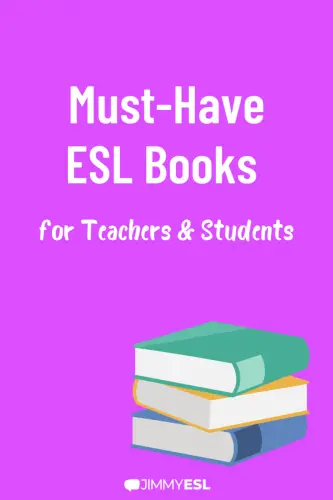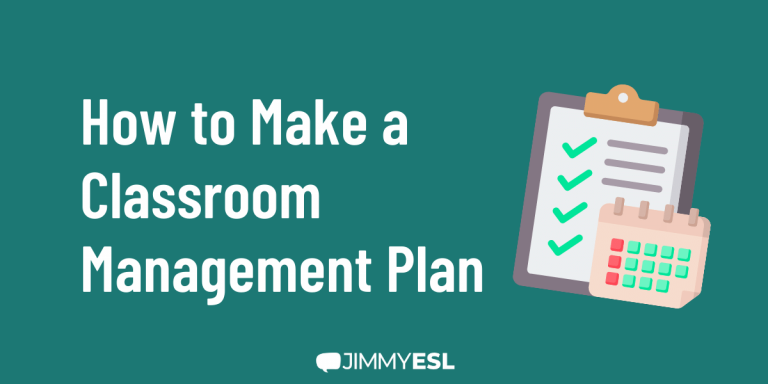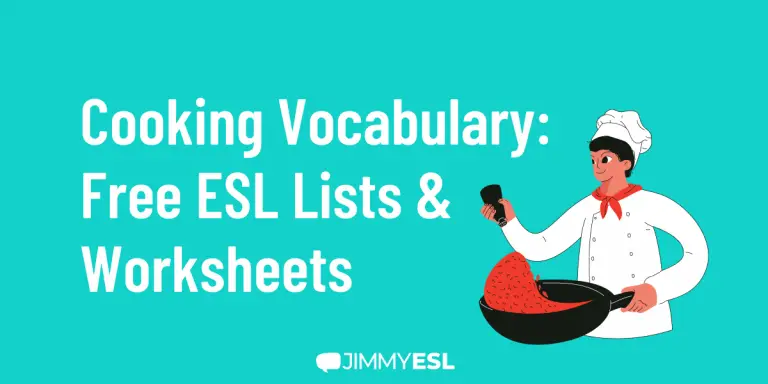Must-Have ESL Books for Teachers (and Students)
There are so many ESL resources out there, books especially.
But, which are the best? The essentials? The desert island books that no ESL teacher should be without?
Let’s take a look at the need-to-own ESL books so that you can be confident you are giving your students the very best, every lesson.
Each book is labelled with the target ability level and type of student it is best suited for, along with a roundup of the pros and cons.
This will enable you to find the perfect book for your students and always be delivering the right material.
Essentials
Magic Time 1 & 2 (Beginners – Preschool)
[amazon fields=”019401617X” value=”thumb” image_size=”large” image_class=”my-aawp-img” tracking_id=”j4t_jimmyesl-20″]
[amazon link=”019401617X” title=”The Magic Time books” tracking_id=”j4t_jimmyesl-20″] are perfect for preschool/kindergarten students. Written by Kathleen Kampa and Charles Vilina (and released by Oxford University Press) these two books give you a reliable resource to help with the very youngest of students.
These books are made up of colourful scenes, fun games, catchy music and movement ideas which focus on building speaking, listening, and pre-writing skills in a fun and inviting way.
As this book is aimed at preschoolers, you will find that the book doesn’t race along, trying to cram in as many concepts as possible. Rather, it is designed to build a solid foundation for later English language learning and ensure that your students will have fun discovering the language for the first time.
In each chapter, you will find two vocabulary pages made up of mostly nouns, along with a simple sentence that introduces some new grammar.
In the first level, there are two verb pages and a phonic alphabet section every three chapters. Then, in the second level, there is one verb page and phonic alphabet practice every chapter. As well as this, there’s a review section every 3 chapters to help test retention.
Pros
- Great games and fun, bright scenes which are perfect for young students.
- Great pace, doesn’t rush things and builds a solid foundation for future learning.
Cons
- Focuses mostly on speaking and listening. While you can dabble with writing and reading, these are not heavily featured.
[amazon link=”019401617X” title=”Buy Magic Time books on Amazon” tracking_id=”j4t_jimmyesl-20″]
Let’s Go (Beginners – Children)
[amazon fields=”0194626180″ value=”thumb” image_size=”large” image_class=”my-aawp-img” tracking_id=”j4t_jimmyesl-20″]
[amazon link=”0194626180″ title=”The Let’s Go series” tracking_id=”j4t_jimmyesl-20″] is arguably the best choice for children just starting to learn English.
It was first released in 1990 by Oxford University Press and it is now used in over 160 countries around the world and is up to its 5th edition. As you can see it has had plenty of time to refine its formula and has gained massive popularity since its first release.
Each chapter takes a topic such as family, food, colours etc and utilises conversations and questions to put emphasis on spoken English from the start. Every chapter finishes with a review so you can test your student’s progress as you advance throughout the book.
Each chapter has a phonics section, designed to help independent reading. After a new area of phonics is introduced, there are accompanying stories, songs and chants to give the student even more practise with that sound.
If that wasn’t enough, there are a host of games, homework and other activities which give plenty of variety to keep your students engaged and having fun throughout your classes.
Pros
- The bright colours and fun text makes these books perfect for young learners and particularly beginners.
- Great for developing spoken English and pronunciation.
Cons
- Although good for beginners, this is not a good choice for teens or adults. The songs and bright imagery may obviously be a little patronizing!
[amazon link=”0194626180″ title=”Buy the Let’s Go book on Amazon” tracking_id=”j4t_jimmyesl-20″]
American English File & New English File (Beginners – Teens/Adults)
[amazon fields=”019477614X” value=”thumb” image_size=”large” image_class=”my-aawp-img” tracking_id=”j4t_jimmyesl-20″]
[amazon fields=”019438425X” value=”thumb” image_size=”large” image_class=”my-aawp-img” tracking_id=”j4t_jimmyesl-20″]
Another Oxford University publication. The American English File is the result of Christina Latham-Koenig and Clive Oxenden’s collaboration.
The series starts from beginner (A1) and advances through to C1 with an emphasis on grammar, vocabulary and pronunciation in each lesson.
Each chapter introduces a theme (hello, we’re Canadian, what’s in your bag etc.) Each of these themes is practical that can be used in day to day conversation. Grammar, vocabulary and pronunciation are then used to support the newly introduced topic.
There are two versions of this series: [amazon link=”019477614X” title=”American English File” tracking_id=”j4t_jimmyesl-20″] focuses on American English, while [amazon link=”019438425X” title=”New English File” tracking_id=”j4t_jimmyesl-20″] focuses on British English. This allows you to use this material regardless of which style you teach.
While this series is a little less colourful compared to something like the Let’s Go series, there are still plenty of diagrams and images to make it more inviting to your older students and things are laid out in an inviting and easy to understand manner.
Pros
- Includes plenty of material.
- Suitable from beginners to advanced.
- Great balance of grammar and vocabulary.
Cons
- Not appealing for younger students.
[amazon link=”019477614X” title=”Buy the American English File book on Amazon” tracking_id=”j4t_jimmyesl-20″]
[amazon link=”019438425X” title=”Buy the New English File book on Amazon” tracking_id=”j4t_jimmyesl-20″]
Market Leader (Business – Adults)
[amazon fields=”1408237032″ value=”thumb” image_size=”large” image_class=”my-aawp-img” tracking_id=”j4t_jimmyesl-20″]
Despite having an elementary book, [amazon link=”1408237032″ title=”Market Leader” tracking_id=”j4t_jimmyesl-20″] is very much an intermediate to advanced level series.
It will cover the basics such as introductions but will move through at a fairly quick pace, so make sure your students already have a good foundation of the language.
That being said, the focus of this series is business. Your most likely students will be people already somewhat comfortable with English and just need to finetune things to make their work-life easier.
This is the series that excels at that.
The Market Leader series covers the 4 major skills (reading, writing, listening and speaking). What’s more, these are all done in the context of business, utilising meetings, phone calls etc. to make these situations extremely relevant to your students.
Another plus is the audio and transcripts for conversations throughout the book. Not only are these great to work within lessons but can be useful for a student wanting to train their listening skills outside of class.
Pros
- Ideal for intermediate to advanced students.
- Niche material for business English.
- Covers the 4 core skills (reading, writing, listening and speaking).
Cons
- Not suitable for beginners.
[amazon link=”1408237032″ title=”Buy the Market Leader book on Amazon” tracking_id=”j4t_jimmyesl-20″]
Check Your English Vocabulary for IELTS (Advanced – Teens/Adults)
[amazon fields=”1472947371″ value=”thumb” image_size=”large” image_class=”my-aawp-img” tracking_id=”j4t_jimmyesl-20″]
Written by Rawdon Wyatt, [amazon link=”1472947371″ title=”this bestselling coursebook” tracking_id=”j4t_jimmyesl-20″] is designed to give a huge boost to an IELTS student’s vocabulary.
Although this could, in theory, be used for any student, it is mainly suited to those preparing for the IELTS exam.
Not only does it teach words and phrases that are great in general situations (such as IELTS speaking), it also teaches very niche vocabulary that is needed for things like the written IELTS section.
Part 1 of the academic writing section can be challenging, as students need a very scientific, objective way of communicating. This book gives both the vocabulary necessary to excel in such areas as well as plenty of exercises to strengthen and reinforce this area.
The exercises are really well written and the book is written in such a way that it can be useful in class as well as in self-study time. This makes it ideal for students preparing for IELTS as they will spend a lot of time studying by themselves as well as with a teacher.
Don’t think of this as purely a vocabulary resource either, as this book also covers grammar, comprehension and spelling.
Pros
- The perfect resource for IELTS students.
- Well written exercises and relevant vocabulary.
- Contains IELTS-style Speaking and Writing tasks with sample answers.
Cons
- Very specific to IELTS students, so other resources may be better for other students.
[amazon link=”1472947371″ title=”Buy the IELTS coursebook on Amazon” tracking_id=”j4t_jimmyesl-20″]
Grammar Books
As well as the essential resources above, here is a selection of bonuses that can also be a great addition to your teaching armoury!
English Grammar in Use
[amazon fields=”0521189063″ value=”thumb” image_size=”large” image_class=”my-aawp-img” tracking_id=”j4t_jimmyesl-20″]
Do you want to brush up on your grammar? Or maybe you just want a solid reference for when you build your grammar lessons. Whatever the case, [amazon link=”0521189063″ title=”English Grammar in Use” tracking_id=”j4t_jimmyesl-20″] is the only book you need, to cover anything you need to know with regards to grammar.
It’s laid out beautifully and as well as solid definitions for each topic, it also contains a host of exercises which are great for in-class or for setting as homework.
[amazon link=”0521189063″ title=”Buy the English Grammar in Use book on Amazon” tracking_id=”j4t_jimmyesl-20″]
English Phrasal Verbs in Use
[amazon fields=”1316628094″ value=”thumb” image_size=”large” image_class=”my-aawp-img” tracking_id=”j4t_jimmyesl-20″]
Here’s one for your advanced learners (C1 – C2) that want to take that extra step in improving their fluency. [amazon link=”1316628094″ title=”English Phrasal Verbs in Use” tracking_id=”j4t_jimmyesl-20″] has around 1000 phrasal verbs, split up into various topics (such as work, nature, food etc).
As well as the explanations, exercises are included to help retention and build confidence in their use. This is great to be used in class or even to recommend to students who want to expand their phrasal verb collection in their own time.
[amazon link=”1316628094″ title=”Buy the English Phrasal Verbs in Use book on Amazon” tracking_id=”j4t_jimmyesl-20″]
Activity Books
ESL Games for the Classroom
[amazon fields=”1641521090″ value=”thumb” image_size=”large” image_class=”my-aawp-img” tracking_id=”j4t_jimmyesl-20″]
Do you struggle with coming up with ideas for fun classroom games? This is where [amazon link=”1641521090″ title=”ESL Games for the Classroom” tracking_id=”j4t_jimmyesl-20″] comes to the rescue. Giving you 101 activities, split up into 6 categories (speaking, listening, reading/writing, vocabulary, spelling and grammar).
These games require minimal preparation so you can start using them immediately to take the stress out of lesson planning.
[amazon link=”1641521090″ title=”Buy the ESL Games for the Classroom book on Amazon” tracking_id=”j4t_jimmyesl-20″]
Dictionaries
New Oxford American Dictionary
[amazon fields=”0195392884″ value=”thumb” image_size=”large” image_class=”my-aawp-img” tracking_id=”j4t_jimmyesl-20″]
You don’t always have access to a computer to check definitions and pronunciation. This is where having a physical resource can save you!
The [amazon link=”0195392884″ title=”New Oxford American Dictionary” tracking_id=”j4t_jimmyesl-20″] contains more than 350,000 words and phrases. With plenty more notes and illustrations etc, to say this is thorough would be an understatement. The most important part I’ve found is the phonetic spelling which allows me to check when I have my doubts on the pronunciation of a particularly rare word!
[amazon link=”0195392884″ title=”Buy the New Oxford American Dictionary on Amazon” tracking_id=”j4t_jimmyesl-20″]
Teaching & Education
Exploring Psychology in Language Learning and Teaching
[amazon fields=”B01HOFFTV8″ value=”thumb” image_size=”large” image_class=”my-aawp-img” tracking_id=”j4t_jimmyesl-20″]
If you have been teaching for a while and really want to step up your teaching game then this is essential reading.
It not only looks at the psychology of learning but specifically the psychology of learning with regards to language. [amazon link=”B01HOFFTV8″ title=”Exploring Psychology in Language Learning and Teaching” tracking_id=”j4t_jimmyesl-20″] will illuminate what exactly happens inside the head of a language learner and I’ve found myself seeing every lesson in a different way since reading it.
[amazon link=”B01HOFFTV8″ title=”Buy the Exploring Psychology… book on Amazon” tracking_id=”j4t_jimmyesl-20″]







